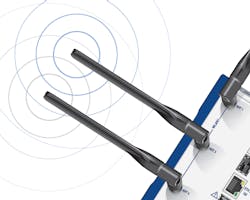Wireless connections are being used more and more across the industrial landscape. One of the primary drivers of this increased wireless use is that many users want to leverage industrial wireless to realize the efficiencies promised by Industrial Internet of Things (IIoT), but are hesitant to move forward due to concerns about reliability or security. Despite these concerns, it’s important for users to realize that wireless technology and standards have vastly improved and today it is possible to deploy robust, reliable and secure industrial wireless solutions.
In fact, there are several ways to save costs and improve productivity with industrial wireless applications:
· Wireless data collection can be a more efficient option in places where data is currently collected manually, such as in energy monitoring systems or from a remote device.
· Remote video monitoring. A live video feed can help you monitor remote or hazardous areas, which will help make your workplace safer.
· Mobile workforce. Remote management and even control of production systems using wireless networks can make workers more productive.
· Backing up wired connections.Wireless technology can provide redundancy for wired systems and help ensure a network stays up and running (with zero failover) in the case of wired network failures.
· Networking older equipment. Legacy devices can be retrofitted with wireless connections to get instant status updates, providing insights from assets that were not previously networked.
Before implementing any of these industrial wireless applications, however, it’s vital to ensure that your wireless network is designed properly and securely. Proper due diligence of a wireless network for industrial applications to ensure that it is deployed securely and monitored regularly includes:
- Vulnerabilities Analysis. Understand the vulnerabilities and associated risks of your wireless network. It is possible to implement a zero-cost assessment on your own, using these tips.
- Divide the network into operational zones and conduits. By dividing large networks into smaller ones, it’s possible to improve the manageability, reliability and security of systems and mitigate unintentional errors.
- Review the latest wireless standards. Advances in technology and standards have made industrial wireless applications more stable, reliable, fast and secure, and a lot easier to deploy. One example of this is the Parallel Redundancy Protocol (PRP), which can improve industrial wireless reliability. Learn more about PRP in this white paper: Parallel Redundancy Protocol Notably Improves Industrial Wireless Reliability.
- Identify the application’s needs. The network must be designed around the intended application, including data rates, coverage area, distance, obstacles, frequency needs, security and redundancy.
- Determine the physical needs of the network. Physical network needs could include mounting locations, power availability or housing requirements.
- Select the right equipment. Look for equipment features, such as easy disablement of telnet, that will keep wireless infrastructure secure.
- Determine the appropriate wireless operating mode depending on the application. This could include access points, access clients or point-to-point (multi-point) modes.
- Implement real-time monitoring. Use the cloud for real-time threat intelligence and automatically program your industrial network to recognize new threats.
Learn more about industrial wireless networking by attending Belden’s Industrial Ethernet Infrastructure Design Seminar being held Oct. 19-22, 2015, in Schaumburg, Illinois. For more information, or to register, visit http://www.belden.com/designseminar.

